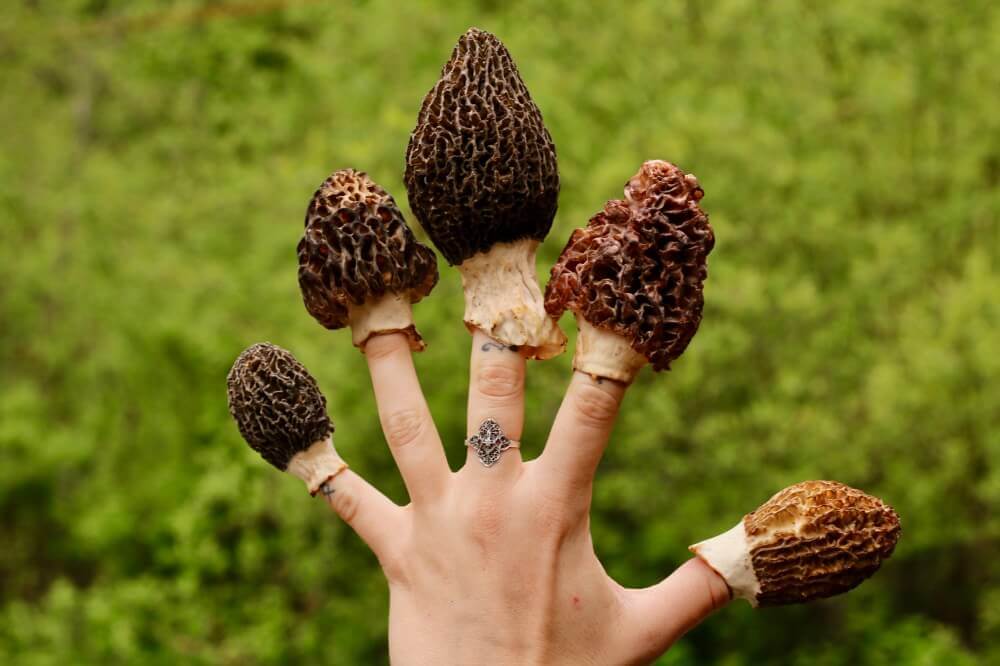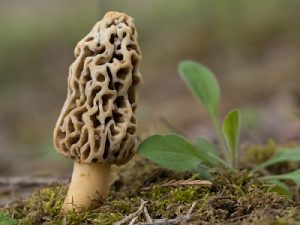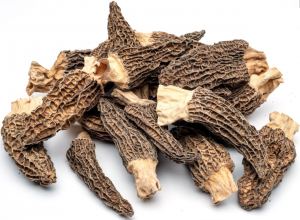
A reminder that morels are hollow. Photo by Modern Forager.
Morels are perhaps the most foraged and prized fungi in North America. There are folks who forage for nothing but Morels and grew up doing so with their parents. They are esteemed in Europe as well so it was natural for immigrants to America to look for morels and continue the foraging tradition. Morels are so coveted that hunters not only do not reveal their “patches” but give out disinformation. Several states require you to be certified to pick them even for private use.

Morels need cool soil to reproduce.
There are some 50 species between North America and Europe. In North America 14 new species were announced in 2012 bringing the total to 19 (when previously they thought there might be five or so species.) The species names are in flux because it’s first come first served. For example: If a species in Europe and North American has the same name and it’s decided they are two different species the first one gets to keep the name, the second one has to be changed. And of course not everyone will accept the evidence they are different thus the naming tempest grows. We just call them Morels…
A dried ounce of morels (28.4 grams) has: 84 calories, 8 grams of protein, 12 grams of carbohydrates, 2 grams of fat, and 4 grams of fiber. it has 59 RE of vitamin A, 1 mg of vitamin C. B vitamins are: B1 (thiamin) 00.3 mg, B2 (riboflavin) 0.64 mg, and B3 (niacin) 2.50 mg. Potassium is 490 mg, phosphorus 339 mg, calcium 33 mg, sodium 10 mg, and iron 8.72 mg.

Morels dry well.
The nutrition for fresh morels follows but remember they always must be cooked. A 100 grams has: 31calories, 3.12 grams protein, 0.57 grams fat, 5.1 grams carbohydrates and 2.8 grams of fiber. There’s half a gram of sugar and it is glucose. No vitamin A or C but there is 206 IU of vitamin D with 5.1 mcg of D2. B vitamins are B1 (thiamin) 0.069 mg, B2 (riboflavin) 0.205 mg B3 (niacin) 2.252, B5 (pantothenic acid) 0.44 mg, B6 (pyridoxine) 0.136, and B9 *folate) 9 mcg. The mineral line up is: Potassium 411 mg, phosphorus 194 mg, calcium 43 mg, sodium 21 mg, magnesium 19 mg, iron 12.18 mg, zinc 2.03 mg, copper 0.625 mg, manganese 0.587 mg, and selenium 2.2 mcg.
This wondrous species does not get into the deep south. During my training to be certified to sell mushrooms one of the things we learned was Morels need ground temperatures of about 55 F for some 11 days for to reproduce. That never happen in warm areas. But they like my cousin’s farm in South Carolina.
The genus Morchella might be from a German word for mushroom “morchel” in the Dead Latin feminine form. Morel is also from Dead Latin and means brown.
Green Deane’s Itemized Plant Profile
IDENTIFICATION: Large fruiting body with a distinct head that is thimble-like or sponge-like and has a pitted surface, usually on a short stem, color ranges rom blonde to dark brown. The honey-combed cap has irregular holes and attaches directly to the stem. Inside there is a hollow cavity that runs from the top of the mushroom down the stem to the bottom.
ENVIRONMENT: Forests (hard and soft woods) old orchards, open ground, drive ways, under hedges… where ever they want.
TIME OF YEAR: May is the target month but they can show up in summer fall and winter. In spring look in warming weather after a cold spell.
METHOD OF PREPARATION: Must be cooked. Raw morels can cause digestive issues.

